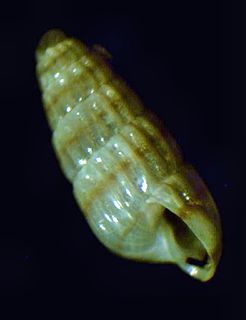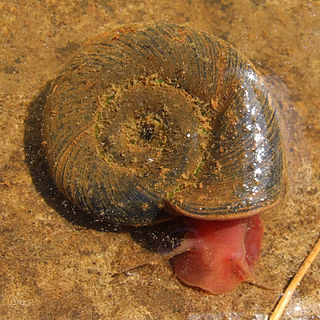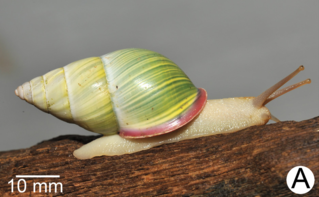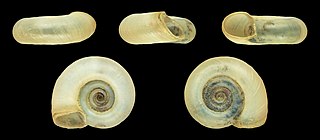Related Research Articles
Sinistral and dextral, in some scientific fields, are the two types of chirality ("handedness") or relative direction. The terms are derived from the Latin words for "left" (sinister) and "right" (dexter). Other disciplines use different terms or simply use left and right.

Turbonillinae is a subfamily of mostly minute parasitic sea snails, marine gastropod molluscs in the family Pyramidellidae, the pyrams and their allies.

Chrysallidinae is a taxonomic group of very small sea snails, marine gastropod mollusk in the family Pyramidellidae, the pyrams and their allies.

Odostomellini is a taxonomic tribe of minute sea snails, marine gastropod molluscs within the family Pyramidellidae the pyrams and their allies.

The gastropod shell is part of the body of a gastropod or snail, a kind of mollusc. The shell is an exoskeleton, which protects from predators, mechanical damage, and dehydration, but also serves for muscle attachment and calcium storage. Some gastropods appear shell-less (slugs) but may have a remnant within the mantle, or the shell is reduced such that the body cannot be retracted within (semi-slug). Some snails also possess an operculum that seals the opening of the shell, known as the aperture, which provides further protection. The study of mollusc shells is known as conchology. The biological study of gastropods, and other molluscs in general, is malacology. Shell morphology terms vary by species group. An excellent source for terminology of the gastropod shell is "How to Know the Eastern Land Snails" by John B. Burch now freely available at the Hathi Trust Digital Library.

Planorbidae, common name the ramshorn snails or ram's horn snails, is a family of air-breathing freshwater snails, aquatic pulmonate gastropod molluscs. Unlike most molluscs, the blood of ram's horn snails contains iron-based hemoglobin instead of copper-based hemocyanin. As a result, planorbids are able to breathe oxygen more efficiently than other molluscs. The presence of hemoglobin gives the body a reddish colour. This is especially apparent in albino animals.

Planorbarius corneus, common name the great ramshorn, is a relatively large species of air-breathing freshwater snail, an aquatic pulmonate gastropod mollusk in the family Planorbidae, the ram's horn snails, or planorbids, which all have sinistral or left-coiling shells.

Euhadra is a genus of air-breathing land snails, terrestrial pulmonate gastropod mollusks in the subfamily Bradybaeninae of the family Camaenidae.

Amphidromus is a genus of tropical air-breathing land snails, terrestrial pulmonate gastropod mollusks in the family Camaenidae. The shells of Amphidromus are relatively large, from 25 mm (0.98 in) to 75 mm (3.0 in) in maximum dimension, and particularly colorful. During the 18th century, they were among the first Indonesian land snail shells brought to Europe by travelers and explorers. Since then, the genus has been extensively studied: several comprehensive monographs and catalogs were authored by naturalists and zoologists during the time period from the early 19th to the mid 20th centuries. Modern studies have focused on better understanding the evolutionary relationships within the group, as well as solving taxonomic problems.

Neoplanorbis is a genus of small, freshwater, air-breathing snails. They are aquatic pulmonate gastropod mollusks in the family Planorbidae, the ram's horn snails.

Neoplanorbis tantillus is a species of very small air-breathing freshwater snail, an aquatic gastropod mollusk in the family Planorbidae, the ram's horn snails. This species is endemic to the United States. In 2012, it has been declared extinct by the IUCN Red List of Threatened Species.

Enidae is a family of air-breathing land snails, terrestrial pulmonate gastropod mollusks.

Turbinella pyrum, common names the chank shell, sacred chank or chank, also known as the divine conch, sometimes referred to simply as a conch, is a species of very large sea snail with a gill and an operculum, a marine gastropod mollusk in the family Turbinellidae. This species occurs in the Indian Ocean.

Amphidromus inversus is a species of air-breathing land snail, a terrestrial pulmonate gastropod mollusk in the family Camaenidae.
Megalena crassa, is a species of air-breathing land snail, a terrestrial pulmonate gastropod mollusk in the family Enidae.
Biomphalaria andecola is a species of air-breathing freshwater snail, an aquatic pulmonate gastropod mollusk in the family Planorbidae, the ram's horn snails.

Biomphalaria peregrina is a species of air-breathing freshwater snail, an aquatic pulmonate gastropod mollusk in the family Planorbidae, the ram's horn snails.

Biomphalaria havanensis, common name the ghost rams-horn, is a species of air-breathing freshwater snail, an aquatic pulmonate gastropod mollusk in the family Planorbidae, the ram's horn snails.

Ramusculus is a monotypic genus of air-breathing land snails, terrestrial gastropod mollusks in the family Enidae. The sole species lives in the Crimean Peninsula. The only species belonging to Ramusculus is Bulimus subulata. Zebrina (Ramusculus) mienisi Gittenberger 1986 living in Erzurum Province was also assigned to Ramusculus, but was subsequently placed in a separate genus, Ayna Páll-Gergely, 2009.
Left-right asymmetry refers to differences in structure across the mediolateral plane in animals. This plane is defined with respect to the anteroposterior and dorsoventral axes and is perpendicular to both. Because the left-right plane is not strictly an axis, to create asymmetry, the left and right sides need to be patterned separately.
References
- ↑ Páll-Gergely (2009). "Revision of the Turkish Ramusculus taxa with description of Ayna gen. nov. (Gastropoda: Pulmonata: Enidae)". Journal of Conchology 40(1): 73–77.
- ↑ Gittenberger, Edmund (1986). "Two new species of Enidae (Mollusca Gastropoda: Pupillacea) from Turkey". Zoologische Mededelingen. 60 (13): 209–216.
| | This Enidae-related article is a stub. You can help Wikipedia by expanding it. |